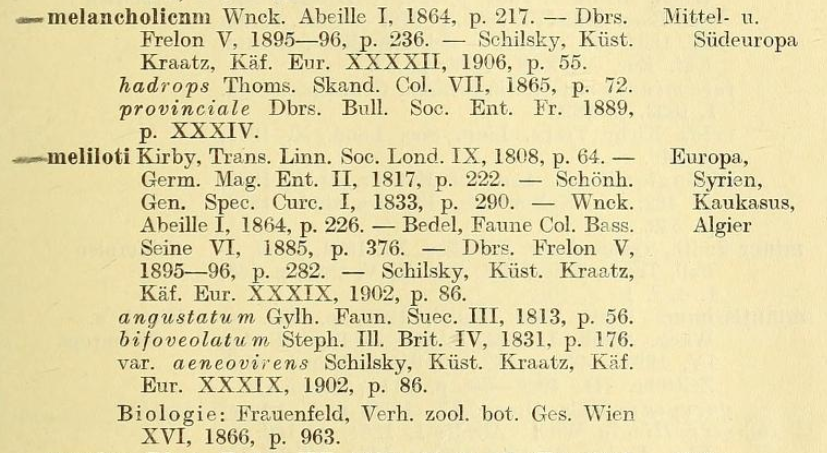Weevil resources
Last modified: 2025-08-11
Something missing? Any comments or questions? Write me an email!
This page is listing the most basic sources of information on weevils all around the world. It is meant to get you started if you’re struggling to get an overview.
Dont worry if something is not accessible for free or even out of print. Scientists help each other in such cases, just write an email.
Must read
Those two works provide an overview about phylogeny, classification, biology and history of science:
Oberprieler, R.G., Marvaldi, A.E., Anderson, R.S. (2007): Weevils, weevils, weevils everywhere. Zootaxa 1668. DOI: 10.11646/zootaxa.1668.1.24 [Free Access on Researchgate]
Leschen, R.A.B., Beutel, R.G. (Eds.), (2014): Arthropoda: Insecta: Coleoptera: Volume 3: Morphology and Systematics (Phytophaga). Handbook of Zoology. DE GRUYTER 1668. DOI: 10.1515/9783110274462
While those two have a global scope, there are some more important works about weevils with a smaller regional focus. When you’re outside of that region, large parts may not be relevant to you, but the introductory chapters may contain valuable general information on weevils.
Worldwide
Important contact: Weevil Workers (global weevil research community): curculionoidea.org
The weevil workers are an informal group of weevil researchers. Notable activities include an annual "Weevil Workers Meeting", which is an online conference. The community also provides a lot of useful information on their website, and is generally very helpful (reach out to them!).
Checklists
There is no up to date worldwide checklist for all weevil species. The most recent comprehensive attempt to list every weevil species of the world was the “Coleopterorum Catalogus auspiciis et auxilio”, which at the same time was the last attempt to catalogue every beetle species. If you don’t find a more recent source, this is your fallback.
Bouchard, P., Bousquet, Y., Davies, A.E., Alonso-Zarazaga, M.A., Lawrence, J.F., Lyal, C.H.C., Newton, A.F., Reid, C.A.M., Schmitt, M., Slipinski, S.A., Smith, A.B.T. (2011): Family-group names in Coleoptera (Insecta). Zookeys 88, 1–972. DOI: 10.3897/zookeys.88.807
This work summarizes all families, subfamilies, tribes and subtribes of Coleoptera. Some of the classification is outdated by now, but it still is the most important summary available.
Alonso Zarazaga, M.A., Lyal, C.H.C. (1999): A World Catalogue of families and genera of Curculionoidea (Insecta: Coleoptera) excluding (Scolytidae and Platypodidae). Entomopraxis, Barcelona, 315 pages, ISBN: 84-605-9994-9. [Free access to scan]
This monumental checklist contains all genera and higher classification of weevils. The higher classification is partly outdated (see e.g. Bouchard et al 2011), but the overview on genera (and synonymies between genera) is extremely valuable. Two papers where published with corrections and additions:
Alonso-Zarazaga, M.A., Lyal, C.H.C. (2002): Addenda and corrigenda to ‘A World Catalogue of Families and Genera of Curculionoidea (Insecta: Coleoptera).’ Zootaxa 63. DOI: 10.11646/zoootaxa.63.1.1
Lyal, C.H.C., Alonso-Zarazaga, M.A. (2006): Addenda and corrigenda to A World Catalogue of Families and Genera of Curculionoidea (Insecta: Coleoptera). 2. Zootaxa 1202. DOI: 10.11646/zootaxa.1202.1.2
Coleopterorum Catalogus
The “Coleopterorum Catalogus auspiciis et auxilio” was published in 170 parts, which where later arranged in 31 volumes, from 1910 to 1940.
A collection of (hopefully) every part of the Coleopterorum Catalogus dealing with weevils (excluding Scolytinae and Platypodinae) can be found here.
The monumental piece of work is still relevant for several reasons:
- For many regions and taxonomic groups, it remains the most recent comprehensive checklist available.
- Many entomological collections with historical roots are still organized according to the Catalogus. As its taxonomy is now highly outdated and differs from modern classifications, the Catalogus is often the only tool for locating specimens in museums.
- It is a key historical document. Understanding the historical classification of weevils is essential for interpreting older entomological literature. The Catalogus also served as the foundation for many later works and can be used to trace the origins of information (including errors).

Valid species are printed in bold. The first citation following each name is the original description; subsequent citations refer to additional taxonomic literature. Synonymous names are given in italics, but for the variations (var.) I’m not exactly sure if they where also considered synonymous. Occasionally, references concerning biology or other topics are included under the corresponding headings (here ‘Biologie’, German for ‘biology’). Distributional data is found on the right, written in German.
Wilhelm Junk, the publisher of the original Coleopterorum Catalogus auspiciis et auxilio, was Jewish. After fleeing Nazi Germany to the Netherlands, he and his wife tragically took their own lives in December 1942, just before the Gestapo arrived to arrest and deport them. Another series named “Coleopterorum Catalogus Supplementa” was started to keep the Catalogus updated, but it eventually ceased to be published.
Nowadays, we tend to rely on online databases such as Catalogue of Life or GBIF. I noticed they do not meet the necessary standards for entomological work, as they are either incomplete or contain too many errors, which stem from automated data aggregation. For taxonomic work, it’s important to stick to sources which where carefully compiled by experts.
TaxonWorks (Database of Weevils Worldwide, in progress)
A group of weevil researchers is compiling a comprehensive database, which is already in a very complete state for the Entiminae, the largest subfamily of Curculionidae: curculionidae.github.io/taxa/
The site “curculionidae.github.io/taxa/” is a frontend page (“TaxonPages”) that accesses a database maintained in TaxonWorks. Since TaxonPages is currently under active development, it does not yet display all the data that can be stored in TaxonWorks itself. You can use the TaxonPages site to find synonymies, and for a growing number of species, you’ll also find images and distribution data. If you have images, especially of type specimens, you are very welcome to contribute!
Anthribidae (Worldwide)
A comprehensive resource on Anthribidae, including a checklist with global scope, is hosted at anthribidae.github.io/
Keys (Worldwide)
Europe (or Western Palearctic)
Important contact: Curculio Institute - Center for Studies on Western Palearctic Curculionoidea): curci.de
The Curculio Institute is an association of weevil researchers, both amateurs and academics. On the website, you can access articles from their journals "Weevil News" and "Snudebiller" (discontinued) for free. They also have high-quality images of many western palearctic weevils, catalogs for certain groups of western palearctic weevils, and keys. Access to some keys is limited without a membership (only text, no images).
The Curculio Institute is also organizing field trips, which are perfect to get in touch with other weevil enthusiasts, and to learn from each other.
Macaronesian Islands (Canary Islands, Madeira, Azores)
Macaronesia is a unique biogeographic region, with unique resources on weevils:
Stüben, P. E. (2022): Weevils of Macaronesia. - Canary Islands, Madeira, Azores (Coleoptera: Curculionoidea). Curculio Institut, Mönchengladbach, 784 pages, ISBN: 978-3-00-068416-6
Illustrated catalog with keys to all weevils of Macaronesia.
Machado, A. (2022): The Macaronesian Laparocerus. Taxonomy, Phylogeny and Natural History.. Turquesa ediciones, Santa Cruz de Tenerife, 681 pages, ISBN: 978-84-16785-99-5
I have not read this work, but it seems to be a monumental monography.
Stüben, P.E. et al.: The Macaronesian Islands - an Encyclopedia of Curculionoidea (Coleoptera). Available online at https://curci.de/institute/lecharancon/catalogue_4/catalogue_4.php
Illustrations, distributional data, life history data, all compiled by members of the Curculio Institute.
To be continued
Something missing? Any comments or questions? Write me an email!
